In today’s complex financial landscape, businesses are drowning in a sea of bank statements. In 2022, a staggering 98.6% of Americans held transaction accounts, generating an unprecedented volume of financial data.
For businesses processing thousands of bank statements daily—from insurance companies to financial institutions, bank statement processing presents a challenge and an even bigger opportunity for automation.
Traditional manual processing and reconciling, which consumes an average of 10-12 hours per week, is no longer an option. It often leads to errors, delays, and missed insights, making statement management a logistical nightmare.
In this article, we’ll explore applications of AI and automation for bank statement processing. We’ll also guide you through setting up an efficient bank statement processing system and share best practices to transform this data flood into a strategic asset.
What is bank statement processing?
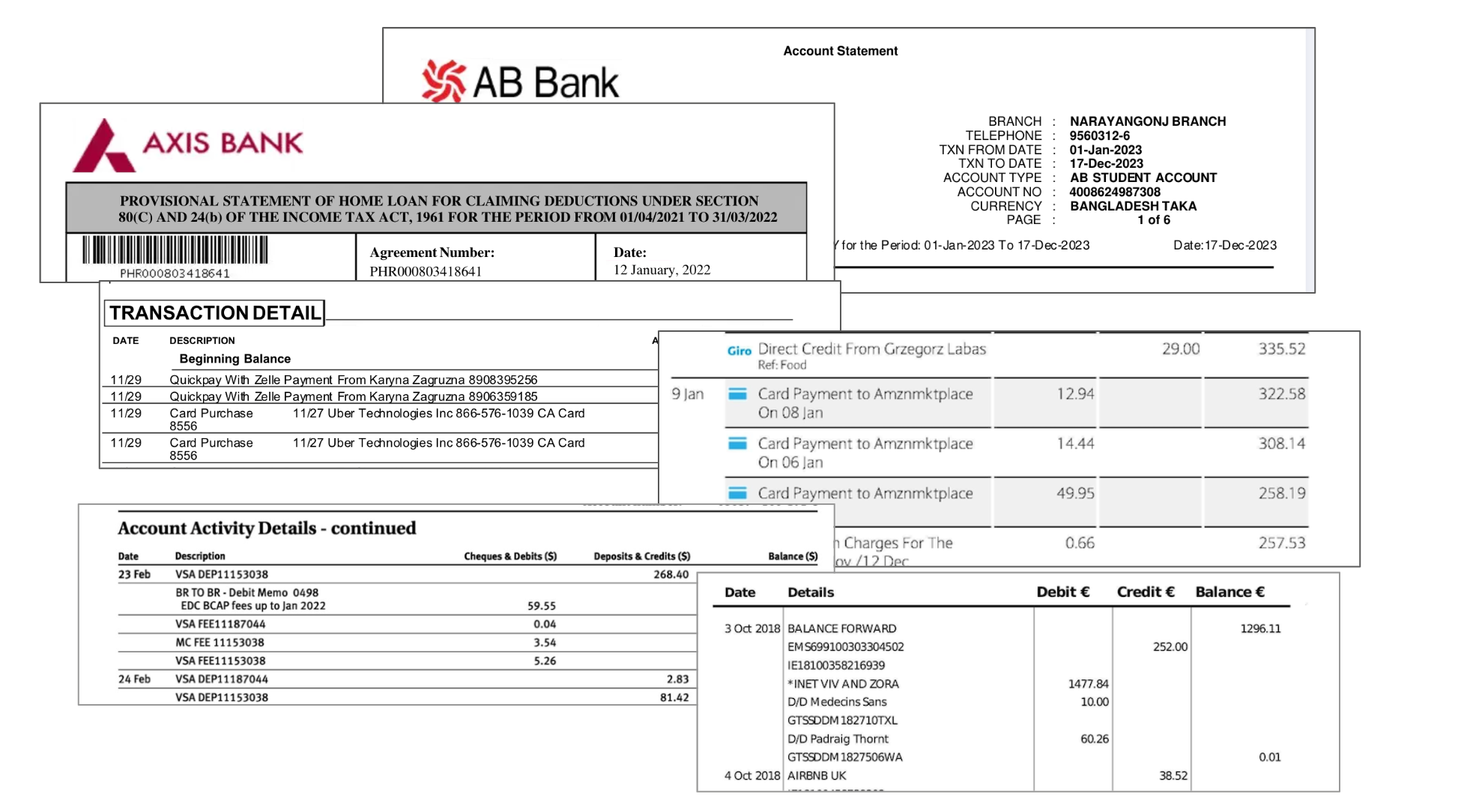
Bank statement processing is extracting and analyzing financial data on bank statements.
- It involves extracting key details from bank statements, such as transaction amounts, dates, descriptions, account balances, payee names, account numbers, and transaction types (e.g., debit or credit, etc.
- The bank extract information is then converted into a structured format for these and other accounting operations.
- The extracted data is then sent for bank statement analysis, further processing, and accounting.
Bank statement processing is essential for accurate reconciliation, auditing, and financial reporting.
In recent years, AI-powered software tools using natural language processing (NLP) and machine learning (ML) have revolutionized this process.
These tools enable businesses to process statements faster and more accurately by automating transaction data extraction, categorization, and analysis. The result is improved efficiency and scalability in financial operations, reducing human errors and saving time for higher-value financial tasks.
Steps in bank statement processing
Let’s look at the steps involved in bank statement processing.
Gathering bank statements
Bank statements come in various formats, such as email attachments, PDFs, physical copies, or spreadsheets, each requiring a different approach.
Traditionally, accountants and bookkeepers manually input data from these bank statements into their accounting software.
💡
1. Use an automated centralized platform for data standardization and extraction.
2. Ensure all relevant information is accessible in one place for efficient processing and analysis.
3. Ensure all statements are properly scanned and readable.
4. Maintain an efficient audit trail for future retrieval.
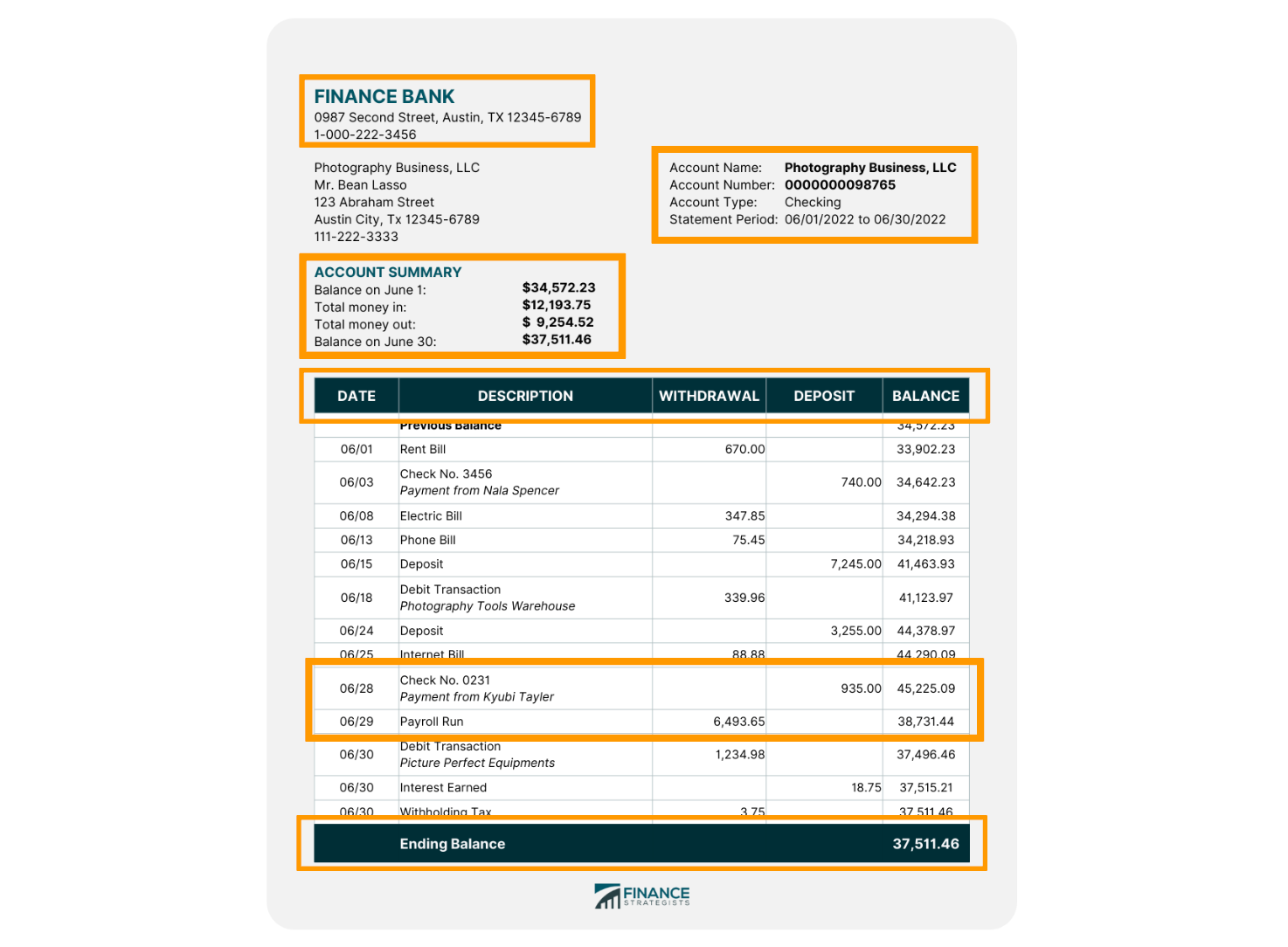
Data extraction tools automatically extract pertinent information from bank statements using machine learning-enhanced optical character recognition (OCR) technology.
These tools can identify key details such as transaction dates, amounts, and descriptions, reducing the time and effort spent on manual data entry.
These tools come in different formats, like template-based data extraction tools, which work best on consistent bank statement templates and advanced AI-powered OCR software.
💡
1. Implement automated data extraction solution with highly accurate OCR.
2. Regularly train the ML-powered data extraction tool to improve recognition capabilities and achieve higher accuracy.
3. Ensure compatibility with multiple statement formats for seamless integration (applies to template-based data extraction tools).
4. Monitor extraction accuracy and implement feedback loops to improve the process continuously.
5. Set up rule-based workflows to identify and remove any duplicate entries and human review for complex or ambiguous transactions.
Reconciliation
This step involves matching the extracted data with the company’s internal records.
For instance, if the bank statement shows a $1,000 deposit on a specific date, it matches the corresponding entry in the accounting records. AI and machine learning-enhanced tools can perform these comparisons quickly and accurately.
💡
1. Fully automate the reconciliation process, including import and data matching.
2. Use advanced matching engines to create customizable match rules.
3. Regularly analyze reasons for variances (for eg: format differences, fraud, duplicate records)
Discrepancy identification
During reconciliation, any mismatches are flagged for further review. For example, if the bank statement lists a $200 withdrawal not recorded in the company’s books, this discrepancy must be identified and addressed promptly.
💡
1. Enable automated flagging alerts for discrepancies.
2. Implement reporting mechanisms to streamline the identification process.
3. Ensure issues are resolved efficiently and timely.
Adjustments
Once the accounting team identifies and explains discrepancies, they make the necessary adjustments. For instance, if an error in the recorded amount of a transaction is discovered, the accountant corrects it in the accounting system to ensure accuracy.
💡
1. Establish a structured adjustment process with thorough documentation.
2. Use accounting software with built-in tracking for all adjustments.
3. Incorporate peer reviews to enhance accountability.
4. Regularly train staff on adjustment procedures to minimize errors.
Transaction analysis
After reconciliation, businesses often analyze the transaction data for insights. Reviewing spending patterns can reveal consistent overspending in certain categories, prompting a review of purchasing practices.
💡
1. Use financial analytics tools that integrate with your bank statement processing platform to analyze transaction data for trends.
2. Focus on key performance indicators (KPIs) such as spending patterns and cash flow.
3. Create visual reports and dashboards for stakeholders to interpret easily.
Reporting
Finally, the processed data is summarized into reports highlighting the organization’s financial status. These reports can include insights on cash flow, expenditures, and overall financial health, providing stakeholders with a clear understanding of the company’s financial position.
💡
1. Develop customizable reports that highlight key financial metrics.
2. Automate reporting tools for timely and regular report generation.
3. Regularly review reporting formats to align with organizational goals.
AI in bank statement processing
Artificial Intelligence (AI) has transformed bank statement processing, making it faster, more accurate, and capable of handling large data volumes. AI-powered systems are revolutionizing how businesses categorize transactions, detect fraud, and maintain financial accuracy.
Here’s a closer look at the AI-enhanced technologies that play a key role in modern bank statement processing:
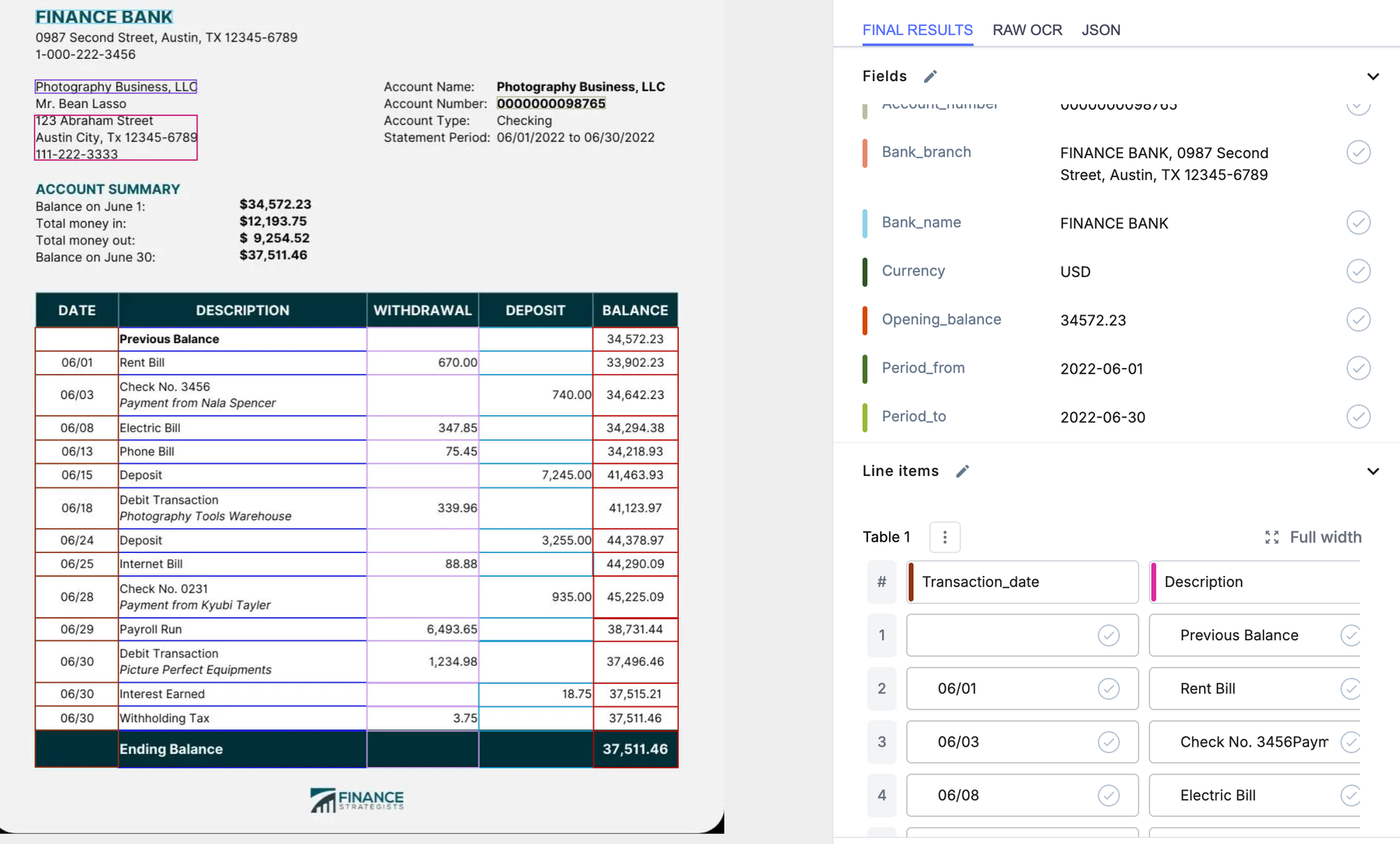
AI-powered Optical Character Recognition (OCR) tools are indispensable in bank statement processing, especially when dealing with unstructured formats like PDFs, scanned documents, and handwritten text.
These tools accurately extract essential details such as transaction amounts, dates, descriptions, and account numbers, regardless of formatting complexity (tables, logos, etc.).
AI-driven OCR is more advanced than traditional OCR. For instance, platforms like Nanonets can extract data from diverse formats and languages seamlessly.
The AI engine reads and organizes data into a structured format, helping businesses streamline reconciliation and financial reporting. This level of automation minimizes manual input, reduces errors, and improves the overall speed and accuracy of financial data management.
💡
Key benefit: Automating OCR processes can reduce manual reconciliation time by up to 90%, allowing businesses to focus on strategic financial decisions.
Natural Language Processing (NLP)
Natural Language Processing (NLP) enhances bank statement processing by interpreting and categorizing transaction descriptions, allowing for better transaction organization.
Unlike simple keyword-based categorization, NLP tools understand the context of transactions. For example, NLP can differentiate between “AMZN*XXXX2” (an Amazon purchase) and “TRANSFER TO SAVINGS” (a bank transfer), accurately categorizing these transactions.
In practice, this allows for more efficient financial management and accurate categorization of expenses, helping businesses maintain accurate budgets, identify spending patterns, and optimize resources.
💡
Key benefit: NLP tools can reduce the manual effort of categorizing transactions by up to 80%, significantly improving the accuracy of financial reporting.
Pattern recognition and fraud detection using ML

Machine Learning (ML) models analyze historical transaction data to detect fraud and recognize patterns in spending behavior. ML tools continuously learn from new transaction data, enhancing their ability to flag anomalies that deviate from established patterns.
For example, if a customer typically makes small purchases from a familiar vendor but suddenly has a large transaction at an unknown vendor, the system might flag it as unusual.
ML-driven fraud detection systems offer real-time monitoring and adaptive learning, enabling businesses to protect their assets from unauthorized transactions and identify potential financial risks early on.
💡
Key benefit: ML fraud detection systems improve risk management and reduce potential financial losses by up to 70%.
Open banking and API integrations
Efficient bank statement processing relies heavily on integrating financial systems such as accounting software, ERP platforms, and databases. With Open Banking and API integrations, businesses can directly connect their bank statement processing tools with these systems, ensuring seamless data flow.
Tools like Nanonets integrate with popular platforms like SAP, Xero, Sage, Netsuite, and QuickBooks, enabling automatic data extraction and direct import of key financial information into accounting systems. This eliminates data silos, reduces manual data entry, and ensures consistency across financial reports.
💡
Key benefit: Businesses can reduce operational costs by 30-40% by automating financial data flow between systems through API integrations.
Automated reconciliation
AI enhances reconciliation by automatically comparing data from bank statements with internal financial records (e.g., general ledgers). AI algorithms match transactions based on details like dates, amounts, and payee names, flagging discrepancies for manual review.
By automating reconciliation, businesses save time and reduce the likelihood of human errors, ensuring that their financial statements are accurate. This process is critical for companies with high transaction volumes, where manual reconciliation is time-consuming and error-prone.
💡
Key benefit: Automating reconciliation cuts reconciliation time by over 50%, while improving accuracy and transparency in financial reporting.
Advanced analytics and predictive insights
With real-time processing, AI-enabled tools can deliver instant insights into financial data. Imagine being able to spot trends as they happen—this means you can budget more accurately and prepare for future expenses without the guesswork.
AI doesn’t just crunch numbers; it can also analyze customer behavior through sentiment analysis. By looking at transaction data and customer interactions, AI helps uncover what customers think and feel. This insight allows you to tailor your services to better meet their needs.
💡
Key benefit: AI analytics tools increase financial forecasting accuracy by up to 25%, providing businesses with deeper insights into their cash flow and financial health.
Contextual learning for continuous improvement
AI systems evolve with contextual learning, adapting to the data they process and the feedback they receive. For example, if a transaction is misclassified (e.g., personal expense versus business expense), the user can correct it, and the system will learn from this correction, improving future categorizations.
With more data and consistent feedback, AI models become increasingly accurate over time, minimizing manual intervention. Businesses implementing AI-powered solutions benefit from systems that continually improve, reducing reliance on human oversight and enhancing overall efficiency.
💡
Key benefit: Over time, contextual learning can reduce manual adjustments by up to 60%, creating a more autonomous financial management process.
How to set up an automated bank statement processing workflow
Here’s a step-by-step guide to setting up a bank statement processing workflow using Nanonets, an AI-powered data extraction tool:
Import all bank statements

- Sign up on app.nanonets.com for free and select Pre-built bank statement extractor.
- Collect and import all your bank statements from various sources, such as Dropbox, Google Drive, Email, Zapier, and OneDrive.
You can also set up an import block based on specific triggers, such as the arrival of a new file in your cloud storage.
Customize data actions
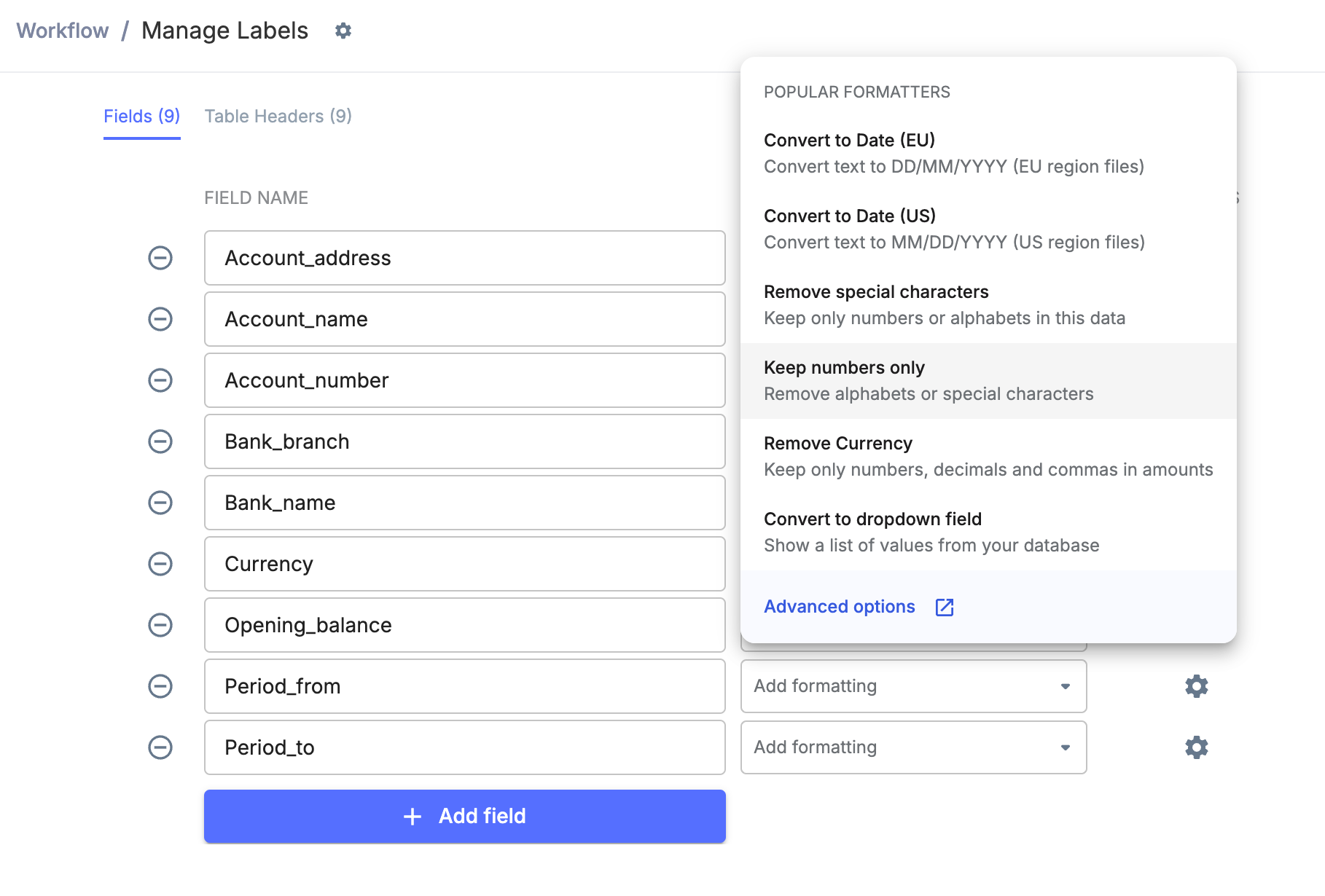
- Set up advanced conditional data action steps for your bank statement processing, such as –
- Review the extracted data and customize your output by keeping only the relevant fields.
- Remove unnecessary fields or add relevant missed fields to ensure a clean output.
Set up rule-based approvals

- Configure and set up rules –
- Flag statements based on fields like high transaction amounts or missing account numbers
- Flag duplicate bank statements
- Setting up approval process with multiple reviewers – mandatory and for flagged
Export for processing
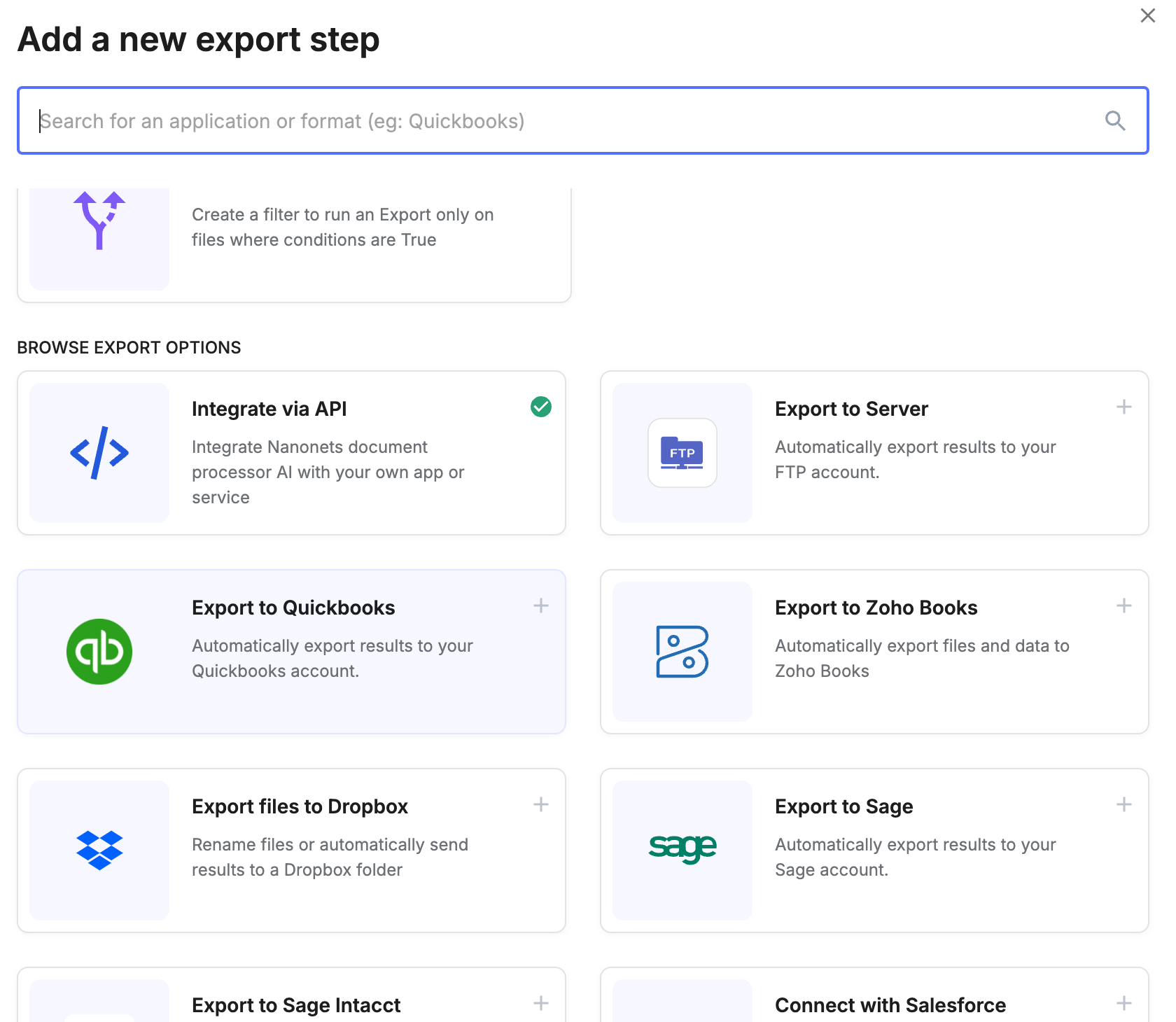
- You can download or export the final results in different formats, such as CSV, XML, Google Sheets, or Excel, or create a shareable link to share with the team.
- For post-extraction processing, integrate with third-party tools using built-in integrations –
- Integrate with accounting and ERP software like Quickbooks, Zoho Books, Sage, Xero, Netsuite
- Database export options, such as PostgreSQL, MySQL, and MSSQL.
- Export to custom Python scripts for specialized processing
- Or integrate with any tool via API
Best practices for automated bank statement processing
To ensure successful automated bank statement processing, consider the following best practices:
Integration with existing financial systems
Create a digital ecosystem by integrating your automated bank statement processing tools with existing financial systems.
This integration should go beyond simple data transfer; aim for intelligent interactions where processed statement data automatically triggers relevant actions in your accounting software, such as updating cash flow forecasts or flagging potential discrepancies for review.
Data security and compliance
Protecting sensitive financial data should be a priority. Encryption ensures data security both when stored and when transmitted.
Limiting access to only authorized personnel, implementing Multi-Factor Authentication (MFA), and employing data masking techniques reduce the risk of data breaches.
To maintain data privacy and user trust, always stay compliant with regulations like GDPR, HIPAA, and SOC.
Third-party vendor management
When working with external vendors, vet their security protocols and compliance measures to ensure they meet industry standards.
Establish legal agreements that outline how data should be handled and conduct regular assessments to verify that vendors adhere to your security and operational requirements.
Clear communication is essential to maintain strong relationships and address any issues promptly.
Monitor and review
Regularly auditing data quality is vital for maintaining accuracy and compliance.
Use feedback loops to refine AI algorithms and improve processing accuracy. Keep detailed logs of transactions and data changes to ensure accountability and compliance with internal and external standards.
Structured workflows, including approval processes for data exports, can further enhance transparency and efficiency.
System maintenance and updates
Adopt a DevOps approach to system maintenance, enabling continuous updates and improvements without disrupting daily operations.
Implement an AI-powered documentation system that automatically updates SOPs and manuals based on system changes and user interactions.
Create a knowledge graph of your processing system. This will allow staff to visualize interconnections between different components and quickly identify the impact of any changes.

